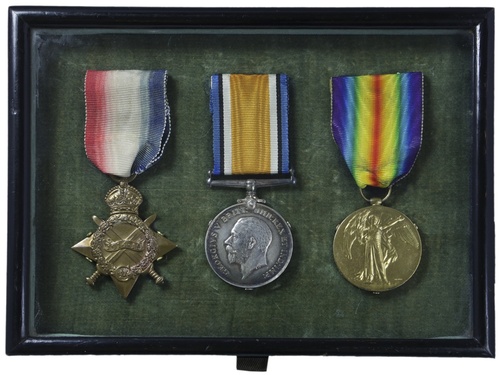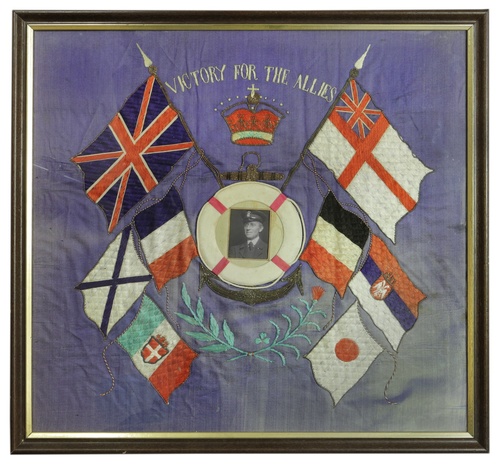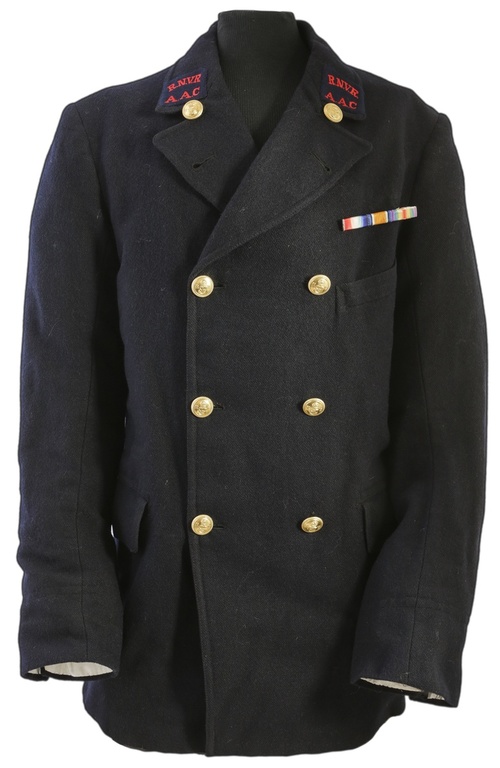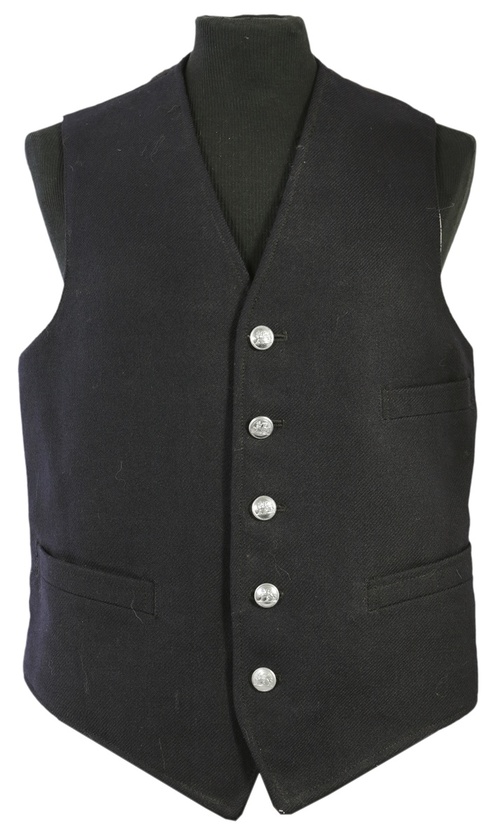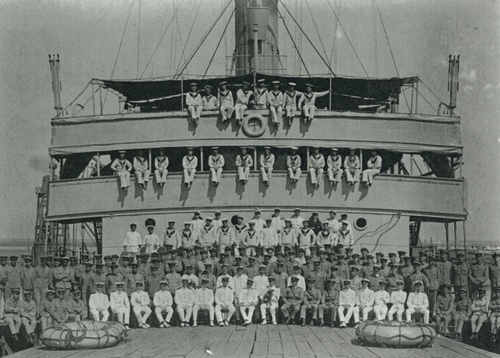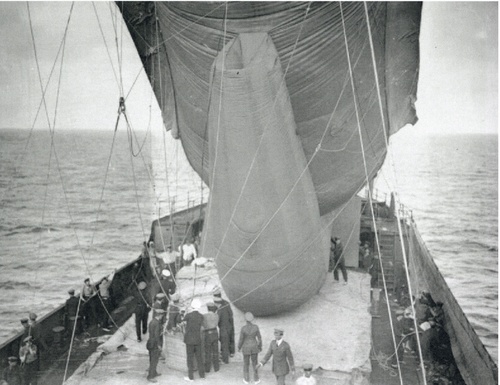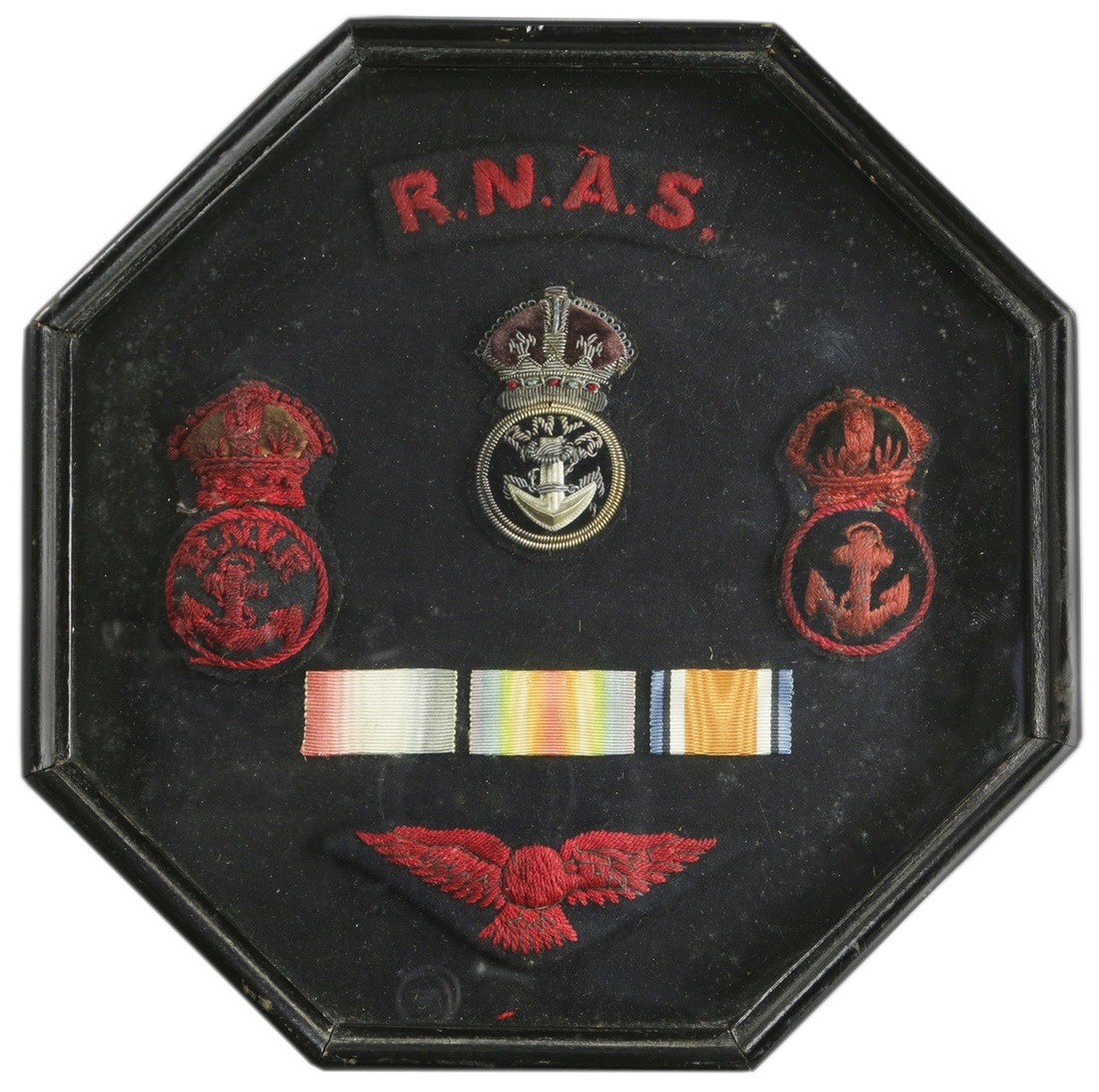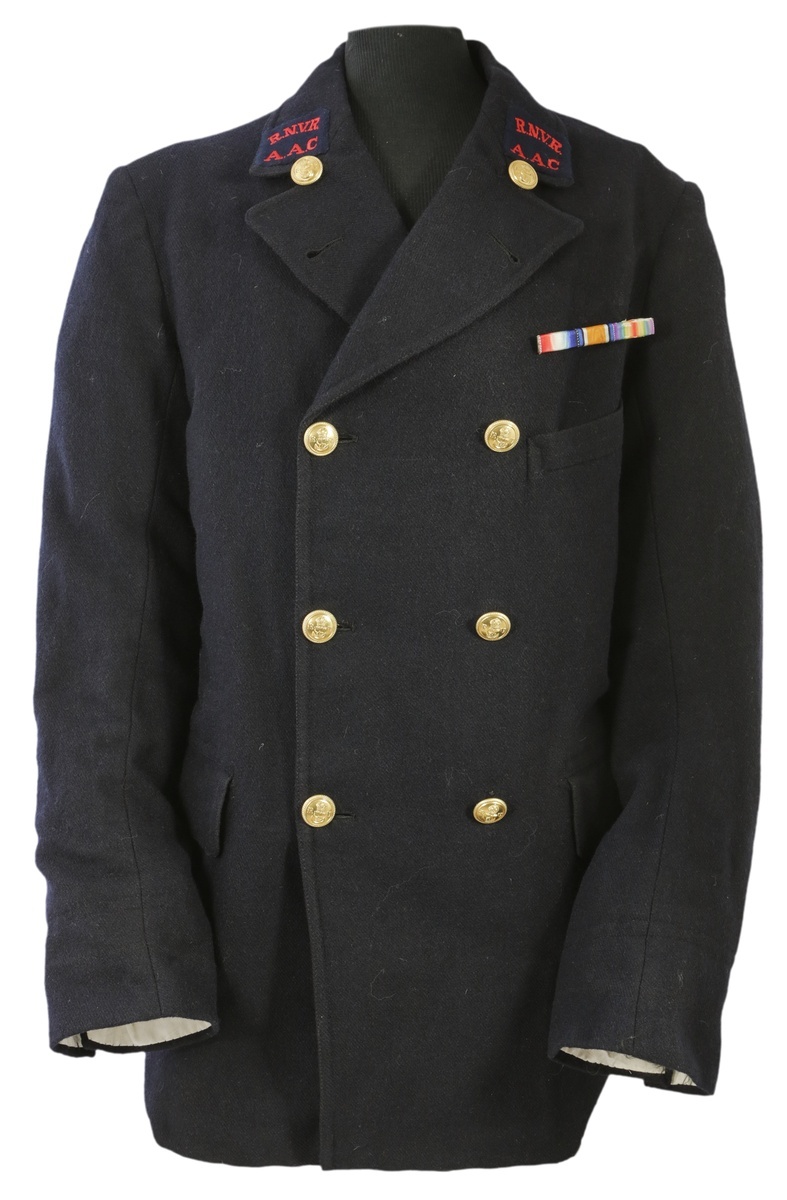Auction: 19001 - Orders, Decorations and Medals
Lot: 714
Sold by Order of a Direct Descendant:
'"We are on a mine cable Sir!" Immediately there is a loud explosion on the starboard side of the foredeck, a huge column of water goes up in the air, fragments of metal with it, some with bits falls on deck. My own mental attitude is one of thankfulness that we have not gone down to death. Then another explosion close to the cook's galley, the first 15ft away, this one 8ft. I then realised we were under shell fire.
Up goes the balloon, 2000ft, & from the bridge deck the whistle sounds, all hands on the balloon - enemy aeroplane approaching and haul for all you are worth. The winch moves as fast as it is possible. Slowly, from far away, I watch the aviatik come for us. It is horrible. We are impotent. We can't strike back, we all know that one hit from a projectile will blow us up. The ship is a box of the very highest explosives. 150 tons of hydrogen, petrol mixtures. There is no shelter aboard H.M.S. Manica from bombs.' (The extensive diaries of W. W. Collins refer.)
Sold by Order of a Direct Descendant:
An important and well-documented group of three to Chief Petty Officer W. W. Collins, Royal Naval Air Service, who served as an Observer with No. 1 Kite Balloon Section aboard the first kite balloon ship, H.M.S. Manica, during the Dardanelles Campaign of 1915, directing the fire of the supporting warships; despite being subject to attack by shore battery and enemy aircraft, Collins, a famous artist, produced an outstanding first-hand written and artistic account of events as they happened
1914-15 Star (LAA. 1025, W. W. Collins, A.B., R.N.V.R.); British War and Victory Medals (L.A.A. 1025 W. W. Collins. C.P.O. R.N.V.R.), mounted in a period frame, together with his Silver War Badge, 'R.N. 7174', the last lacking wearing pin, nearly extremely fine (3)
William Wiehe Collins, was born on 4 August 1862 at Kensington, London, the son of Francis and Mauritius-born Olympe Amelie Collins (née Wiehe). He studied at Lambeth School of Art from 1884-85, followed by the Académie Julian in Paris, developing a talent for landscape and figurative painting, together with architectural and naval studies. On graduation, he exhibited at many of the most influential London galleries including the Royal Academy, developing a reputation for watercolours and pen & ink drawings. Collins was elected to membership of the Royal Institute of Painters in Watercolour in 1898 and the Royal Society of British Artists in 1906.
In 1900, Collins married Jane Blumford and the couple briefly settled at Fulham before moving to The Curatage, East Street, Corfe. He travelled widely across Europe producing a series of books based upon his watercolours, and subsequently sold the originals at the Walker Gallery, New Bond Street, his clients including The Earl of Eldon, the Duchess of Somerset and Rear-Admiral Sir Douglas Brownrigg. A cutting from The Times in 1914 notes his considerable artistic flair:
'Old London, actual London, East End and West End, City and suburb, are all portrayed with that fidelity and delicate interpretation of atmosphere which distinguished Mr. Collins' earlier studies of Italy and Spain. The artist's judicious inclusion of a number of London's quaintest corners and streets on the verge of disappearance makes this exhibition of much historic as well as artistic value.'
Interestingly, this last pre-war exhibition at the Walker Gallery was shared with a German artist, Paul Gutscher - who also shared a passion for watercolours.
Following the outbreak of the Great War, William decided to sign up with his friend and fellow artist Herbert William Hillier. Enlisting together into the London Division of the Royal Naval Volunteer Reserve, they were given the service numbers A.A. 1024 and A.A. 1025, and then both served from 17 February 1915 as Able Seamen at the London shore establishment, H.M.S. President. Collins stated his date of birth as 4 August 1873, which would place him at 41 years of age. This was the 'cut-off' age for the Derby Scheme which was later introduced in the Autumn of 1915 by Herbert Kitchener's new Director-General of Recruiting, Edward Stanley, 17th Earl of Derby, designed to demonstrate whether British manpower needs could be met by volunteers - or whether conscription was necessary. In reality, Collins was over a decade older.
In the early days of the War, the army, with their commitments in Flanders, were hard pressed for men and guns, hence Collins and Hillier began their wartime service defending London from air attack as part of the Royal Naval Volunteer Reserve Anti-Aircraft Corps.
On 15 March 1915 both were posted to the armoured cruiser H.M.S. Bacchante, which was stationed in the Mediterranean - they were subsequently informed of their transfer to the former cargo steamship, H.M.S. Manica. It is most likely that the pair were handpicked for their artistic skills and experience of technical drawings, especially architecture. A keen eye for detail placed them much in demand at a time when accurate maps of the Gallipoli Peninsula were in short supply.
H.M.S. Manica - Balloonatic
The 262ft Manica was launched on 25 September 1900 and served as a cargo and passenger ship for Ellerman Lines until requested by the Admiralty on 11 March 1915, and Commissioned H.M.S. Manica eleven days later. Hired as a Kite Balloon ship, she unloaded her somewhat varied cargo of copper bars, sheepskin bales, drums of crude glycerine and manure, and then proceeded from Sydney to Britain. Upon arrival, she was fitted with a long sloping deck, a dynamo to drive a hydrogen compressor, a winch and two Drachen-type Kite Balloons. On 28 March 1915, she sailed for the Eastern Mediterranean, arriving off Lemnos on 14 April - where she was joined by Collins who had spent the previous days sketching the local area and preparing his kit in incessant drizzle:
'I washed 3 shirts, 3 pairs of pants, socks, hands, but could dry none of them!'
Other diary entries make it clear that preparations for the Gallipoli landings were progressing at pace, despite incessant rain and cold. His superiors were also beginning to notice his artistic talent:
'CO came in & had a long talk, thought it splendid men of our stamp should come out on the show - was very pleased with my work & got me some colours.'
14 April offered a fine day. Manica sailed in the early morning and the balloon was released to 700ft in a 12-15 mile per hour breeze. Passing Lord Nelson, Queen Elizabeth and Prince of Wales, Manica negotiated her way through the minefields and Collins set about compiling maps of the Turkish coastline from aloft; diary entries note the need to raise the balloon from sunrise to sunset, day after day; a gruelling schedule for all involved.
25 April 1915 - the landings begin
As the waves of troops went ashore, Collins found himself spotting off 'Z' Beach, Anzac Cove, and the Pasha Dagh Plateau:
'April 25th, up at 4 am. Cocoa and bread, very acceptable. Had it served out yesterday. Balloon up at 5.10, stayed up till 3.20 pm. 23 Transports round us at dawn increased to 40 by 3 pm. Troops landing during the night, firing commenced at dawn. Did 3 more sections of panorama. Made sketch before breakfast. From what has eked out the result has been 700 Turkish prisoners, one or two trenches taken, 200 of our men killed, 500 wounded.'
The diary entry largely reflected the reality in terms of territory gained, but relied heavily upon hearsay in terms of casualty figures. By nightfall, the ANZAC's had formed a beachhead, albeit much smaller than intended - in places they were clinging to cliff faces with no organised defence system - the exact numbers of casualties remains unknown to this day, but of the two ANZAC divisions who landed at Gaba Tepe, over two thousand men had been killed or wounded.
The next day, Collins was up at 4 a.m. and continued to compile his diary:
'The Australians are almost along the ridge of the hill they went up. They took a field battery and a howitzer with them. The 2nd Brigade is on the beach, ready to advance. Talbot and Bacchante fire where the balloon tells them. Saw swarms of men on beach and going slowly up cliff sides. They have been successful so far but not a single Turk has been seen from the balloon. Hospital ship busy.'
On 27 April, Manica came under sustained shellfire from Turkish batteries - two shells fell close by and it was impossible to tell where they came from. Despite this close shave, the conditions faced by the men ashore seemed far worse:
'Our troops are evidently having a bad time on the hill, shrapnel is bursting all over them & the fire which was on the far side yesterday has returned this.'
Desperately tired, Collins spent the morning sketching in the balloon and continuing to compile his diary. That afternoon, his balloon sighted Turkish transport ships near Najara and directed the 15-inch guns of Queen Elizabeth upon their prey; the largest ship, the Scutari, was hit at a range of 11 kilometers and sank after three salvoes. That evening Collins retired to a cabin and began to prepare a three-dimensional model of the coastline out of papier-mâché; this time, perhaps unsurprisingly given the losses ashore, his superiors seemed less than enthusiastic to receive his work. Sleep could not come soon enough for the men of the Kite Balloon team.
Three days later, the Manica was attacked by an enemy aircraft. According to Collins:
'Here we are, waiting death, waiting it in all sorts of ways. For my part I felt the suspense terrible. 5 minutes since she was first spotted and not a single shot fired at her in response to our calls for help.'
The aircraft missed its target, as did the Turkish shore batteries and the ever-present mines, but for Collins his role aboard Manica was coming to a natural conclusion.
Further adventures
On 1 July 1915, Collins and Hillier transferred to the cruiser Europa, and spent the next month operating off Mudros. Returning to President, Collins was promoted Chief Petty Officer on 1 October 1915, and discharged to shore ten days later.
According to family accounts, Collins later served with the Royal Engineers and went out to Egypt. During this period of time he again sketched and painted watercolours, especially the remaining parts of the Old, Middle and New Kingdoms including Thebes, Luxor and Karnak. These formed part of a large exhibition of his work at Walker's Gallery in October 1916. He later exhibited works on Thomas Hardy's Country and paintings of rural England in 1930; both the Royal Collection and the Victoria and Albert Museum hold his work.
Collins retired to Bridgwater, Somerset, where he died on 16 February 1951.
Sold with the following extensive archive, offering an invaluable source for the collector and historian alike:
(i)
Diary 1: An extremely thorough pocket diary, 13cm x 8cm, written in pencil with daily entries detailing his departure from Roehampton on 22 March 1915, and continuing until 7 June 1915; inscribed 'Private, W. W. Collins, R.N.A.S. No. 1 Kite Balloon Section, Dardanelles 1915' to inside cover - approx. 56 pages, in excess of 7500 words. A fascinating first-hand account of the Dardanelles Campaign and life aboard H.M.S. Manica.
Diary 2: A pocket diary detailing his experiences from 8 August 1915 to 17 September 1915; inclusive of jottings and sketches and 'scrap' annotations.
(ii)
Artists jotting pad: 19cm x 10.5cm, commencing with pencil architectural drawings of London (approx. 16 sketches), followed by some outstanding pencil drawings of ships in the Dardanelles - many with the ships named (approx. 18 sketches). The final scenes display the landings and the positioning of the warships - with two pages of writing describing the scene.
(iii)
Artists drawing pad: 25cm x 19cm, including pencil drawings likely drawn by Collins aboard the balloon at the time shells from the naval barrage were bursting upon the mainland. Many of these drawings are labelled and display a keen eye for three dimensional detail. Some are similar to what one would find upon a modern-day Ordnance Survey Map, with contours and significant features (approx. 18 sketches).
(iv)
Memorandum Book containing accounts and notes pertaining to fishing exploits and the 'Drills, Scores & Experiences etc, of the 20th Middlesex Rifle Volunteer Corps.' - A detailed account of Collin's experiences in the early 1880's, inscribed 'W. W. Collins, Charterhouse, London' to inside cover.
(v)
A thorough collection of contemporary newspaper cuttings relating to Art Exhibitions and reviews by critics, inclusive of reports regarding sales and customers.
(vi)
An appealing contemporary octagonal frame containing R.N.A.S. badges, fabric shoulder titles and silver-bullion R.N.V.R. badge; together with Comrades of the Great War and National Reserve, Dorset, enamel badges.
(vii)
A four-page account, 'War Artist at Gallipoli' by Peter Wright - who, in the appendix, thanks the grandson of W. W. Collins for help with compiling the document.
(viii)
Two original watercolour paintings by W. W. Collins, both signed by the artist and titled 'Suvla Bay 1915', 26cm x 17.5cm, framed and glazed, showing the men going ashore - likely from the vantage point of the balloon aboard Manica.
(ix)
The recipient's very rare Royal Naval Volunteer Reserve - Anti-Aircraft Corps tunic and waistcoat, in blue cloth, the lapels with 'R.N.V.R. A.A.C.' cloth insignia and gilt Naval buttons, with a pin-back riband bar upon the tunic.
(x)
A charming silk and mixed thread 'Victory for the Allies' display piece, bearing the flags of the victorious powers and a central photograph of W. W. Collins, framed and glazed, 57 x 55 cm.
(xi)
A very personal and charming small pocket notebook titled, 'Fish caught by myself from June 1883 to September 1941'. This little notebook contains a very thorough account of all the roach, eels, perch, trout, gudgeon and other species of fish, caught by W. W. Collins in various rivers and coastal locations across the U.K., commencing on 16 June 1883 with an afternoon spent on the banks of the River Thames at Staines. In October 1939, towards the end of the account, he notes, '1 minnow also caught on a fly'.
Subject to 20% VAT on Buyer’s Premium. For more information please view Terms and Conditions for Buyers.
Sold for
£3,800
Sale 19001 Notices
The paintings listed as Part VIII of the footnote comprise the following Lot and are not included in this Lot.

